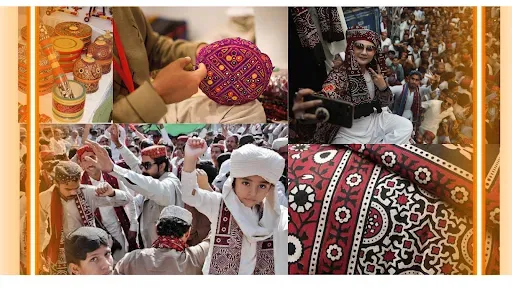Culture of Sindh & its Historical Perspective
What is Culture?
Culture is the identity of any particular group of people, region, area, or country. Similarly, culture is a reflection of the social behavior, institutions, and norms that are found in human societies, in addition to the knowledge, beliefs, arts, laws, customs, capabilities, rituals, and routines of the members of these groups. Culture frequently derives from or is associated with a particular region or location.
In addition, the entirety of a population's ways of life—including its arts, beliefs, and institutions—that are handed down from one generation to the next is what is referred to as culture. Culture has been referred to as a society's way of life. As such, it encompasses dress codes, language, religion, rituals, art, and manners. Language, food, norms, values, and artifacts are the five main cultural symbols.
Comparably, Culture has a variety of characteristics that assist it in bringing about certain changes over time. Learning and knowledge, transmission, symbolism, change, integration, ethnocentricity, and adaptability are examples of these cultural characteristics. culture is a force that urges individuals and communities to bring certain positive changes.
On the other hand, culture is a bond that brings people to come closer on the basis of certain commonalities and similarities on the basis of religion, language, customs, traditions, rituals, events, celebrations, food, and living.
What is Sindhi Culture?
One of the world's oldest cultures, Moen-Jo-Daro's 5000-year-old civilization, can be found in Sindh. The civilization of the Indus Valley is the source of Sindhi culture. Similarly, Sindhi culture owns a unique style that includes pure and nutritious foods, fabrics, music, language, and arts and crafts. Sindh has been formed by the to a great extent desert district, the normal assets it had accessible, and persistent unfamiliar impact.
The land was traversed by the Indus River, also known as the Sindhu River, and its borders were set by the Arabian Sea, which supported the local seafaring traditions. The Sindhis' language, folklore, traditions, customs, and way of life are also influenced by the climate of the area, which explains why they are so distinct from their neighbors. The Sindhi diaspora also follows the Sindhi culture.
History of Sindhi Culture
The city life of a civilization of people with values, a distinct identity, and a culture has been revealed through the Mohen-Jo-Daro excavations. As a result, the Indus Valley civilization, which dates back 5000 years, serves as the foundation for the first definition of Sindhi culture. This is roughly 3,000 years before the arrival of the Aryans. at the point when the metropolitan development in Sindh was at its pinnacle. We find very distinct Sufi music, verbal poetry, folk tales, and indigenous sports (Wanjh wati, Kodi Kodi, Beelarhoo, Thapay Rand).
Language & Poetry in Sindhi Culture
Sindhi was one of the Indus Valley's oldest languages and had a unique literary flavor in both poetry and prose. Like other developed languages, Sindhi poetry has a lot of thought and a variety of genres. Poetry from old Sindh also has an impact on modern languages and accepts the positive influence of some languages including Persian, Hindi, Siraiki, and even English.
Bait (a poem) and Waei (a long narrative poem) are the two primary and original forms of verse found in Sindhi poetry. In addition to being influenced by Persian forms such as Ghazal, Mathnavi, Rubai, and Kaafi, Bait has a slight resemblance to forms Dohas and Sorthas. The sonnet and blank verse have been incorporated into Sindhi poetry since the 1940s.
Triolet, Haiku, Renga Tanka, and other forms were added shortly after Pakistan gained independence in 1947. These forms continue to coexist at this time, albeit to varying degrees, with Azad Nazm ( a free verse poem) having an advantage over all of them. Sindh is well-known for the poetry of Shah Abdul Latif Bhittai, Sachal Sarmast, Sheikh Ayaz, and Ustad Bukhari.
Importance of Sindhi Culture for Sindhi People
Sindhi people need to understand that culture is a beacon of hope that inspires the masses to embrace change. Similarly, culture is a tool and a change agent that can be used to bring equality, justice, peace, freedom, hope, prosperity, and commonality to Sindh. Additionally, the youth of Sindh need to realize that quality education, social harmony, religious tolerance, and economic prosperity are brought about by culture.
Because it is one of the most important aspects of any culture, language plays a very important role. It is how people communicate with one another, form relationships, and feel like they belong to a particular community. This is why loving our culture doesn't only means that we must dance, sing, and celebrate our culture day on the 4th of December every year.
Rather, loving our culture means that we love and prioritize each and everything that is part of our culture. Not only that but we need to promote our culture and let the world know that we do have our own unique culture that promotes peace, equality, love, freedom, diversity, and justice.
The people of Sindh need to realize that culture is not an emotional tool that opportunists use to raise our emotional sentiments just for their personal gains in the name of religion, language, politics, and land. Loving our culture means that we all are equal and there isn't any discrimination among us on the basis of caste, color, creed, religion, politics, wealth, and riches.
Last but not the least, culture has great importance for the people of Sindh. Therefore, we must utilize it to bring prosperity, equality, freedom, and diversity to our communities. Similarly, we can use culture to promote quality education, sincerity, patriotism, and scientific development in Sindh.








Comments